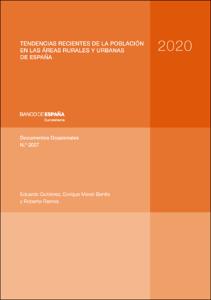Tendencias recientes de la población en las áeras rurales y urbanas de España
Authors
Issue Date
18-Nov-2020
Physical description
40 p.
Abstract
En España, la fracción de la población residente en zonas urbanas ha aumentado desde el 65?% hasta más del 87?% en el período 1950-2018. Este incremento fue especialmente intenso hasta el final de la década de los setenta, durante el período que, en ocasiones, se denomina «de éxodo rural», de modo que la tasa de urbanización se situó en un 82?% en 1981. Desde entonces, el incremento de la tasa de urbanización habría proseguido, si bien a un ritmo significativamente más lento, como resultado de una dinámica poblacional dispar entre las áreas rurales y las urbanas. Estas últimas habrían experimentado un alto dinamismo demográfico desde finales del siglo pasado hasta 2011, para estancarse posteriormente. Las áreas rurales, por el contrario, si bien aumentaron su población hasta 2010, han sufrido intensas caídas poblacionales desde entonces. No obstante, existe una acusada heterogeneidad en la dinámica poblacional de las áreas rurales por tamaño y según pertenezcan o no a un área urbana funcional. En particular, las zonas rurales muy pequeñas (menos de 1.000 habitantes) habrían presentado pérdidas elevadas de población en las últimas décadas. Además, destaca la aportación negativa del crecimiento natural de la población en las áreas rurales, a consecuencia de una estructura poblacional sesgada hacia edades más avanzadas. En contraste, las áreas rurales pertenecientes a algún área urbana funcional habrían experimentado significativas ganancias de población en los últimos años. En el período transcurrido desde mediados del siglo pasado, España habría sido uno de los países europeos con un mayor aumento de la tasa de urbanización, de modo que dicha tasa habría convergido hacia la observada en los países más urbanizados de Europa.
In the period 1950-2018, the share of the population living in urban areas in Spain increased from 65% to more than 87%. This increase was especially strong until the end of the 1970s, during the period that is sometimes dubbed the rural exodus, with this share reaching 82% in 1981. Since then, the share of the urban population has continued to rise, albeit at a significantly slower pace, as a result of uneven population dynamics across rural and urban areas. Urban areas experienced strong demographic momentum from the end of the 20th century to 2011, but have subsequently stalled. By contrast, although the rural population increased until 2010, rural areas have undergone steep population declines since then. However, the population dynamics across rural areas are markedly uneven based on their size and whether or not they belong to a functional urban area. Specifically, very small rural areas (fewer than 1,000 inhabitants) have undergone steep population declines in recent decades. Furthermore, the natural population decrease in rural areas, a consequence of a population structure skewed towards older cohorts, is noteworthy. Conversely, rural areas belonging to a functional urban area have experienced significant natural population increases in recent years. In the period elapsed since the mid-20th century, the increase in the share of the urban population in Spain was among the largest in Europe, such that the percentage has converged with that observed in Europe’s most urbanised countries.
In the period 1950-2018, the share of the population living in urban areas in Spain increased from 65% to more than 87%. This increase was especially strong until the end of the 1970s, during the period that is sometimes dubbed the rural exodus, with this share reaching 82% in 1981. Since then, the share of the urban population has continued to rise, albeit at a significantly slower pace, as a result of uneven population dynamics across rural and urban areas. Urban areas experienced strong demographic momentum from the end of the 20th century to 2011, but have subsequently stalled. By contrast, although the rural population increased until 2010, rural areas have undergone steep population declines since then. However, the population dynamics across rural areas are markedly uneven based on their size and whether or not they belong to a functional urban area. Specifically, very small rural areas (fewer than 1,000 inhabitants) have undergone steep population declines in recent decades. Furthermore, the natural population decrease in rural areas, a consequence of a population structure skewed towards older cohorts, is noteworthy. Conversely, rural areas belonging to a functional urban area have experienced significant natural population increases in recent years. In the period elapsed since the mid-20th century, the increase in the share of the urban population in Spain was among the largest in Europe, such that the percentage has converged with that observed in Europe’s most urbanised countries.
Publish on
Documentos Ocasionales / Banco de España, 2027
Subjects
Población; Tasa de urbanización; Áreas rurales y urbanas; Áreas urbanas funcionales; Population; Share of the urban population; Rural and urban areas; Functional urban areas; Economía regional y recursos naturales; Distribución de las rentas y riquezas de las personas; España
Appears in Collections:












